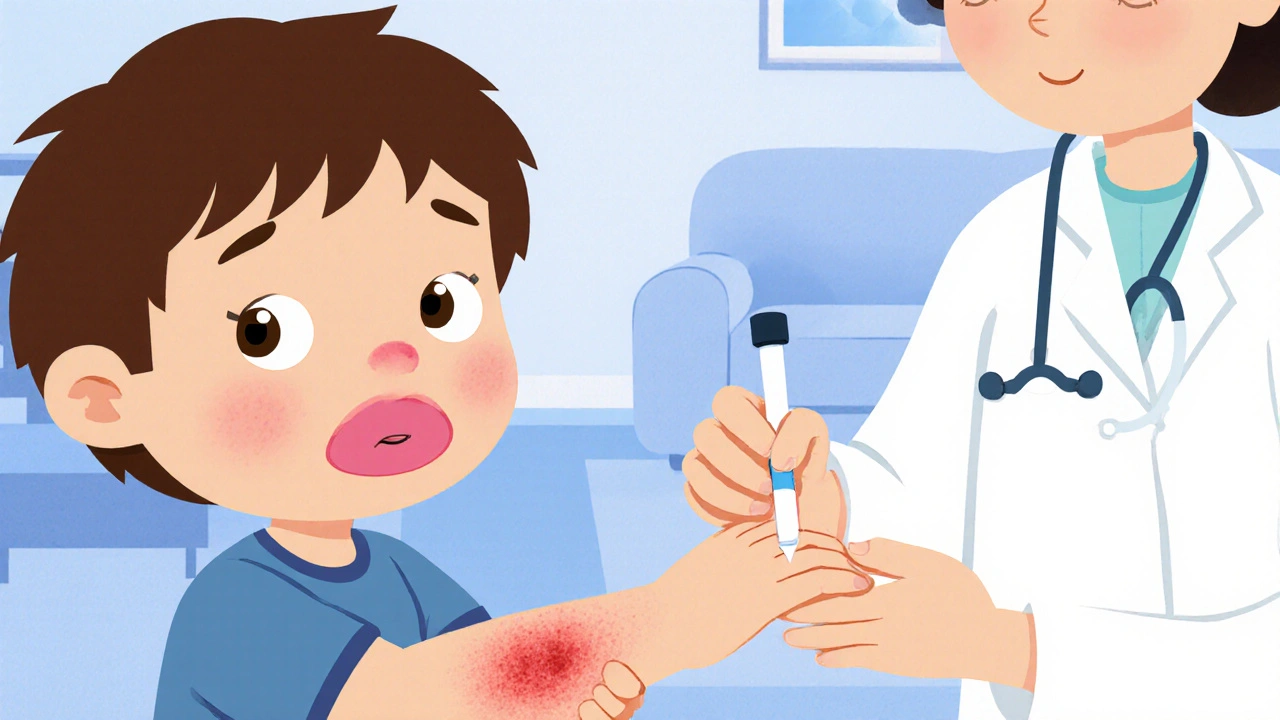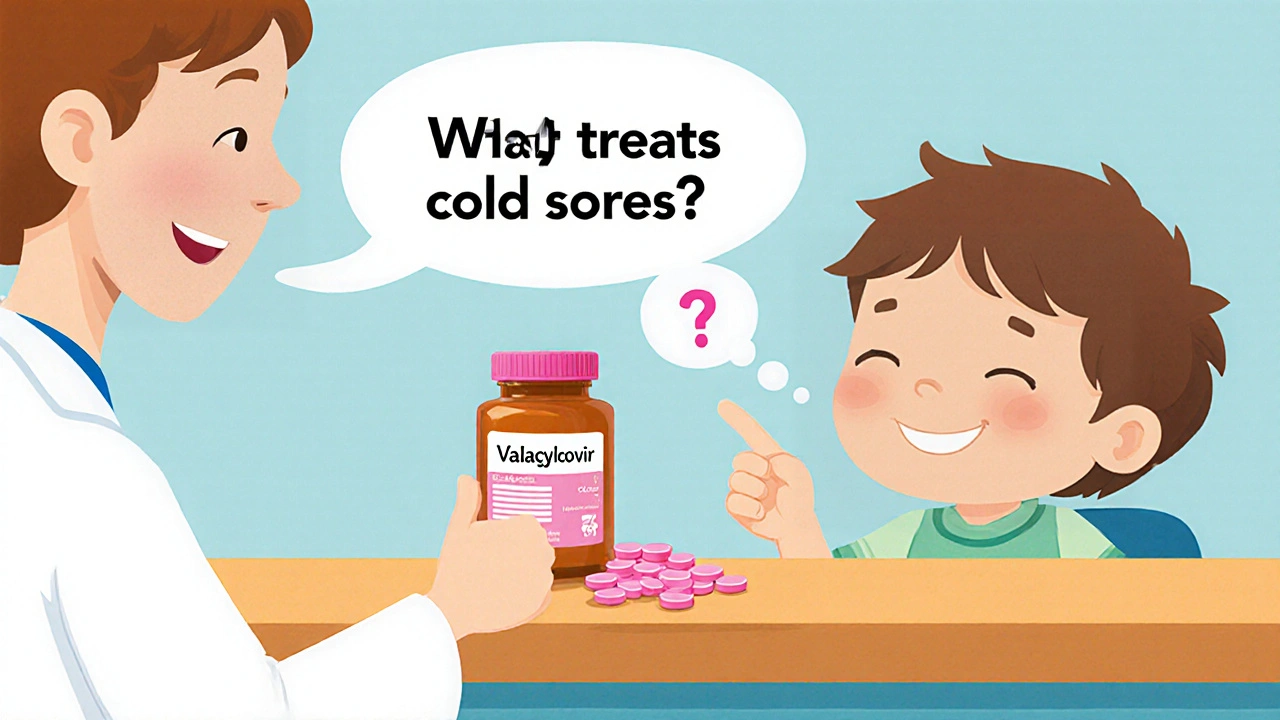Valacyclovir Allergy Symptom Checker
This tool is not a medical diagnosis. If you experience severe symptoms, seek immediate medical attention. This assessment is for informational purposes only.
Note: This assessment is not a substitute for professional medical evaluation. Always consult your healthcare provider for diagnosis and treatment.
When a prescription for valacyclovir lands on the pharmacy counter, most patients assume it’s a straightforward antiviral for cold sores or shingles. But for a small yet important group, that pill can trigger a full‑blown allergy. If you’ve ever wondered what a valacyclovir allergy looks like, how doctors confirm it, or which meds you can safely switch to, you’re in the right place.
What is Valacyclovir and Why Is It Prescribed?
Valacyclovir is a prodrug of acyclovir that converts into the active antiviral in the body. It belongs to the nucleoside analogue class and is primarily used to treat infections caused by the herpes simplex virus (HSV) and varicella‑zoster virus (VZV). In the U.S., common brand names include Valtrex and generic equivalents. Because it offers higher bioavailability than acyclovir, doctors often prefer it for shingles, genital herpes, and occasionally for cytomegalovirus (CMV) in immunocompromised patients.
How Do Allergic Reactions to Valacyclovir Show Up?
Allergy symptoms can be easy to miss, especially when they overlap with typical viral rash or medication side‑effects. Below are the most frequent signs that point to a valacyclovir allergy:
- Itching, redness, or hives that appear within hours of the first dose.
- Swelling of the lips, face, or throat (angioedema) - a medical emergency.
- Respiratory distress: wheezing, shortness of breath, or tight chest.
- Fever, chills, and a generalized body rash that may evolve into blistering.
- Joint pain, muscle aches, or a sudden drop in blood pressure.
If any of these occur, stop the medication immediately and seek medical care. For milder hives, an over‑the‑counter antihistamine can help, but severe reactions need epinephrine and emergency treatment.
Diagnosing a Valacyclovir Allergy
Doctors rely on a combination of clinical history and targeted tests. The key steps are:
- Detailed interview - timing of the rash relative to drug intake, previous exposure, and any known drug allergies.
- Skin prick or intradermal testing - uses a diluted solution of the drug to watch for an immediate wheal-and-flare response.
- Blood work - measuring Immunoglobulin E (IgE) levels can reveal a Type I hypersensitivity. Elevated eosinophils may suggest a delayed reaction.
- Patch testing - for delayed (Type IV) reactions, the drug is applied to the skin under tape for 48 hours.
- Drug challenge (under supervision) - rarely performed, only when the diagnosis is uncertain and the drug is essential.
In practice, a clear temporal link plus positive skin testing confirms an allergy in most cases.

Managing the Reaction: Immediate Steps and Follow‑up
Stopping valacyclovir is the first move. Then:
- Administer oral antihistamines (e.g., cetirizine) for urticaria.
- If swelling threatens the airway, give intramuscular epinephrine and call emergency services.
- Systemic corticosteroids (prednisone 40‑60 mg daily taper) may be needed for severe rash or DRESS (Drug Rash with Eosinophilia and Systemic Symptoms).
- Document the allergy in the patient’s electronic health record with the exact drug name and reaction details.
After recovery, an allergist can discuss long‑term strategies, including cross‑reactivity testing with related antivirals.
Safe Alternatives to Valacyclovir
Not all antivirals share the same allergy risk. Some patients tolerate other nucleoside analogues, while others need a different drug class altogether. The table below compares the most common oral and topical options, focusing on efficacy, typical dosing, and known allergy profiles.
| Alternative | Form | Typical Dose | Pros | Cons / Allergy Concerns |
|---|---|---|---|---|
| Acyclovir | Oral tablet / IV | 400 mg 5×/day (oral) or 5‑10 mg/kg IV q8h | Well‑studied, cheaper, lower bioavailability means less systemic exposure. | Higher dose required for shingles; rare allergic reactions but possible cross‑reactivity with valacyclovir. |
| Famciclovir | Oral tablet | 250‑500 mg 3×/day (herpes); 250 mg 5×/day (shingles) | Once‑daily dosing for some indications; good for patients who dislike frequent pills. | Structurally similar to acyclovir; cross‑reactivity reported in <5% of cases. |
| Topical penciclovir cream | Cream (5%) | Apply 5×/day to lesion until healed (≈5‑7 days) | Directly targets skin lesions; minimal systemic absorption. | Only effective for mild HSV lesions; not suitable for shingles. |
| Topical acyclovir ointment | Ointment (5%) | Apply 5×/day for 7‑10 days | Well‑tolerated, inexpensive. | May cause local irritation; no systemic allergy risk. |
For patients with documented valacyclovir allergy, acyclovir or famciclovir can still be tried after negative skin testing, but many clinicians prefer topical options when the infection is limited to the skin.

Tips to Prevent Future Drug Allergies
Even if you’ve never reacted before, taking a few precautions can save you from a nasty surprise:
- Keep an up‑to‑date allergy list on your wallet or phone.
- Ask your pharmacist to flag any prescriptions that belong to the same drug class.
- If you’ve had a reaction to one antiviral, request cross‑reactivity testing before starting another.
- Consider a medical alert bracelet that mentions “valacyclovir allergy” for emergency staff.
- When switching doctors, bring a printed copy of your allergy documentation.
Quick Checklist for Patients and Clinicians
- Identify symptoms within 1‑2 hours of the first dose.
- Stop valacyclovir immediately; do not self‑restart.
- Document the exact reaction (rash, swelling, breathing difficulty).
- Arrange skin testing or IgE measurement to confirm.
- Select an alternative: acyclovir, famciclovir, or topical therapy.
- Update electronic health records and personal allergy cards.
Frequently Asked Questions
Can I take valacyclovir if I have a mild rash?
A rash that appears soon after the first dose usually signals an allergy. Even a mild rash warrants stopping the drug and consulting a clinician. Sometimes, a non‑allergic rash resolves on its own, but you should never assume it’s safe without professional guidance.
Is cross‑reactivity common between valacyclovir and acyclovir?
Cross‑reactivity occurs in a minority of cases (roughly 2‑5%). Both drugs share the same active metabolite, so skin testing is recommended before switching to acyclovir if you’ve had a confirmed valacyclovir allergy.
What is DRESS and how does it relate to antivirals?
Drug Rash with Eosinophilia and Systemic Symptoms (DRESS) is a severe, delayed hypersensitivity reaction that can involve fever, organ inflammation, and a high eosinophil count. Though rare, DRESS has been reported with several antivirals, including valacyclovir. Prompt drug cessation and systemic steroids are the main treatments.
Are topical antivirals safe for someone with a valacyclovir allergy?
Yes. Topical penciclovir or acyclovir have minimal systemic absorption, so they rarely trigger systemic allergies. Local skin irritation can still occur, so apply a small amount first to test tolerance.
Should I wear a medical alert bracelet?
If you have experienced a severe reaction (e.g., swelling, breathing trouble), a bracelet that says “valacyclovir allergy” can save valuable minutes in an emergency.


Valacyclovir allergies can be tricky because the early signs often look like a normal viral rash. If you notice itching, hives, or swelling within a few hours of the first dose, it’s worth alerting your doctor right away. Even mild symptoms like a rash on the torso should be reported, since they can progress quickly. Stopping the medication promptly and keeping a record of the reaction helps in future prescribing.
First, let me clarify that not every rash after taking valacyclovir is an allergy; many patients mistake a simple drug‑related irritation for a true hypersensitivity, which leads to unnecessary alarm. The key differentiator is timing: an allergic response typically manifests within minutes to a few hours, whereas a pharmacologic side effect may take days. Moreover, the morphology of the eruption matters-urticaria and angio‑edema are hallmark signs of an IgE‑mediated reaction, while a morbilliform rash leans toward a delayed Type IV response. When clinicians suspect an allergy, they should begin with a detailed history, noting any previous exposures to acyclovir or famciclovir, as cross‑reactivity is not uncommon. Skin testing, although not universally standardized for antivirals, can be performed with a diluted solution of valacyclovir to observe a wheal‑and‑flare response; a positive test essentially confirms an immediate hypersensitivity. In cases where skin testing is equivocal or unavailable, serum IgE levels and eosinophil counts can provide supportive evidence, especially when paired with a clear temporal relationship. Patch testing, on the other hand, is the appropriate tool for delayed reactions that emerge 48‑72 hours after exposure and may present as a maculopapular rash. It’s crucial not to rush into a drug challenge unless the therapeutic benefit outweighs the risk, because re‑exposing a truly allergic patient can precipitate an anaphylactic event. If an allergy is confirmed, the next step is documentation: the electronic health record must list valacyclovir as “allergy-hives, facial swelling,” with a precise description of the reaction. For patients who need antiviral therapy, alternatives such as acyclovir, famciclovir, or even topical penciclovir can be considered, but clinicians should assess cross‑reactivity on a case‑by‑case basis. Some individuals tolerate acyclovir despite a valacyclovir allergy, while others react to all nucleoside analogues and require drugs from a different class, like foscarnet. In the acute setting of a severe reaction, immediate management includes antihistamines, systemic corticosteroids for extensive rash, and intramuscular epinephrine if airway compromise is evident. Finally, patients should be educated about wearing medical alert jewelry and informing any future healthcare providers of their valacyclovir allergy to avoid accidental re‑exposure. In summary, proper identification, thorough testing, and clear documentation are the pillars of safe management, and a thoughtful selection of alternative antivirals ensures continued treatment efficacy without risking another allergic episode.
I completely agree with the need for careful documentation.
Indeed, the temporal correlation, coupled with a positive prick test, provides a robust diagnostic confirmation, and it is essential that clinicians not only record the reaction in the patient's chart but also communicate the information to pharmacy databases, thereby preventing inadvertent rechallenge.
Honestly, most of this sounds like overkill – just stop the pill and call your doc, that’s all. 😐
Oh, come on! Dismissing a potential anaphylactic scenario as “overkill” is not only reckless but shows a blatant disregard for patient safety, especially when lives could hang in the balance.
Yo, let’s get real – the valacyclovir drama ain’t just skin deep, it’s a full‑blown saga of immunologic fireworks, and if you’re not vibing with the standard meds, you gotta hunt down those niche antivirals that don’t set off your immune gremlins, ya feel?
We must remember that while it’s vital to respect individual drug reactions, it’s equally important to avoid blanket fear of all antivirals; education and proper testing allow us to target therapy responsibly without compromising care.
True, it’s all bout balence – we cant just throw away good meds becaus of one bad expereince.
Stay proactive, folks! If you suspect a valacyclovir allergy, jump on it fast, get tested, and explore those alternative antivirals – you’ve got this!